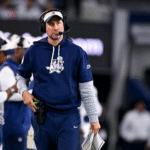In a surprising development from the world of professional hockey, reports have emerged that Patrik Laine, the prolific winger for the Columbus Blue Jackets, rejected a trade to a Western Conference team this summer.
This revelation has sent ripples through the NHL community, stirring speculation about Laine’s future and the dynamics within the Blue Jackets’ organization.
Patrik Laine, known for his powerful shot and goal-scoring ability, has been a key player for the Blue Jackets since his arrival in a trade with the Winnipeg Jets in January 2021.
His performance on the ice has made him one of the most sought-after forwards in the league, leading many teams to express interest in acquiring him to bolster their rosters.
The specific details regarding the team or teams involved in the proposed trade have not been disclosed. However, the fact that Laine turned down a move to a Western Conference team suggests he might have strategic or personal reasons for wanting to stay in the Eastern Conference or remain with the Blue Jackets.
The rejection has sparked widespread speculation about Laine’s preferences and his vision for his career.
For the Blue Jackets, this development could have significant implications. Laine’s decision to reject the trade might indicate a commitment to the team or a desire to work through current challenges and contribute to the club’s long-term success.
It also poses questions about the team’s strategic direction and how they will handle the situation moving forward.
Laine’s decision to stay put may be influenced by various factors, including his relationship with the team, his role within the organization, or personal considerations.
His preference to remain in the Eastern Conference could be strategic, aiming to align with teams and systems that better fit his playing style or offer a more appealing competitive landscape.
From a broader perspective, Laine’s rejection highlights the complexities of player movement and trade negotiations in the NHL. It underscores how personal preferences and career goals can significantly impact trade discussions and team strategies.
As teams adjust their plans and seek new ways to strengthen their rosters, Laine’s choice will likely be a key topic of discussion among analysts, fans, and team officials alike.
Overall, while the specifics of the trade offer remain under wraps, Patrik Laine’s decision not to move to a Western Conference team adds an intriguing layer to the ongoing narrative of player trades and team dynamics in the NHL.
It will be interesting to see how this development influences the Blue Jackets’ strategies and Laine’s future performance on the ice.









